You also might think the New Jersey Meadowlands are nothing more than an unappealing swamp surrounding a sports complex.
You'd be wrong, twice. The greatest joy of exploring the environment, urban or otherwise, is discovering places that aren't just new, but that feel like entirely new worlds. It doesn't happen often when you're staying close to home, but it does happen. A recent "Eco-Cruise" through the New Jersey Meadowlands, conducted by the Hackensack Riverkeeper, revealed a universe previously unknown to this longtime New Yorker, yet closer to my own lower Manhattan haunts than parts of the Bronx.

We didn't even have to get to the Meadowlands to find wildlife. In addition to a flock of Canada geese marching along the road, blocking traffic, this egret rested in a pond in front of a warehouse building along the road.
Leave Manhattan through the Lincoln Tunnel, drive a couple of miles, and you're at Laurel Hill Park in Secaucus (pronounced, as the natives will tell you, SEE-kaw-kus.) "Laurel Hill" sounds bucolic but it's no gentle rise. A remnant of the same volcanic activity that raised the Palisades some 200 million years ago, it sticks out of the surrounding wetlands like a crow among the sparrows.
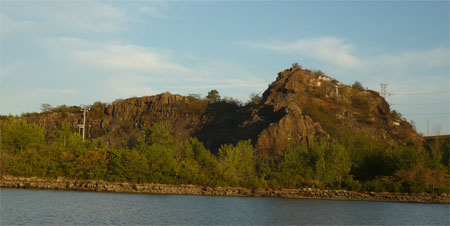
At the boat launch a group of about 15 of us boarded the Edward Abbey, skippered by Captain Bill, the founder of Hackensack Riverkeeper and a bottomless fount of historical detail about the region and the ongoing struggle by environmentalists to preserve some of the wetlands from destructive development. We glided out into the water and past these peaceful little islands of mud and grass:

It's easy to see the high tide line on the marsh grass here:
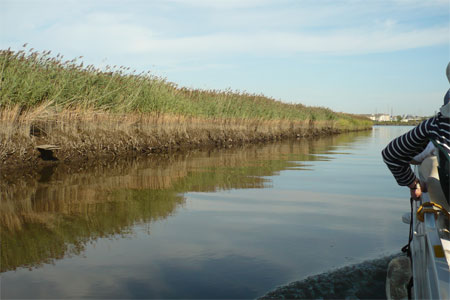
And it's easy to see the birds, too. Among the species we spotted were sandpipers, northern harriers, a few types of egret (including the striking snowy), terns, common gulls, a great black gull, yellowlegs, osprey, cormorants, and several kinds of heron—including the great blue, shown in the last of the following four photos:
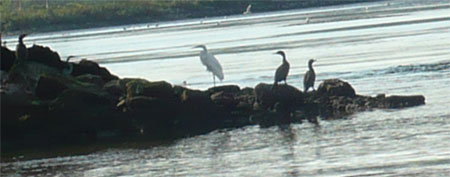
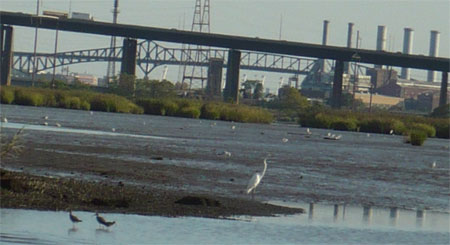


A pair of osprey has nested in a Bloomberg radio tower. Here's one I managed to snap despite the great height and distance:

The works of man take on new aspects when seen from below:

A beautiful sunset made a fine end to the day. These natural wetlands are here for us to enjoy mostly thanks to the tireless work of environmentalists like Captain Bill. But our enjoyment is just a small link in the chain. The ecosystem depends on the wetlands. As I write this, a Category 4 hurricane called Earl is threatening the East Coast of the US. Without wetlands, powerful storms would inundate our low-lying populated areas and grow from damaging to disastrous. The coast has already lost a lot of wetlands. We have to preserve what remains, for our own good if nothing else.

What the Riverkeeper and similar organizations recognize is that in order to muster the political will to preserve the ecosystem, they must make more people aware of the interdependence of its different parts. We can't know that if we aren't aware of what's around us in the first place. And we can't know that if we sit in our houses and apartments and offices all day watching idiotic "reality" shows and checking our Blackberries.
To get people out to enjoy nature, it helps a lot if there's convenient access to beautiful places like these Lands of the Meadow. Creating parks helps. (There's a regulation cricket pitch in Laurel Hill park!) So does holding events where kids and adults can participate in water activities. And so does leading excursions like this "eco-cruise." I can't recommend this trip enough.
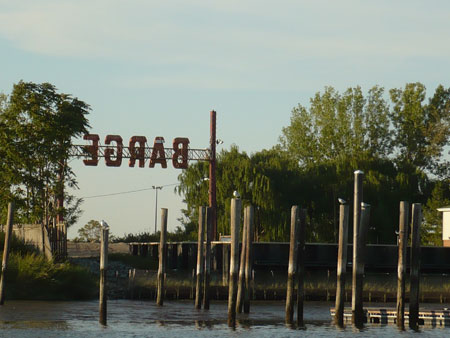
No comments:
Post a Comment